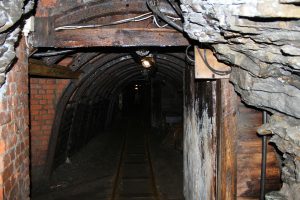Print a Sign-In Sheet | Spanish Version Coming Soon
Over the years, improvements in roof control technology, such as new bolting systems, automated temporary roof support systems, use of cabs and canopies, and mobile roof supports, have all led to a significant reduction in roof and rib fall fatalities. But we must remember that roof and rib hazards are still the greatest safety concern in underground coal mining.
Why is this so? Roof and rib conditions vary from mine to mine, and in some instances from section to section within a mine. The type of sedimentary rock, such as shale, sandstone, and limestone, overlying the coal seam dictates the strength of the mine roof. Combine this variable roof rock with other geologic factors, such as faults, ancient stream channels, slips, joints, and fossils, and one can see why roof control is the most challenging safety problem in underground coal mines.
Mining personnel must cope with constantly changing geologic conditions every day. Each time coal is taken from the mining face, it opens new territory and potentially new hazards. Therefore, it’s important to understand that every coal mine has a unique set of conditions. What works to control roof and rib conditions in one mine may not work at other operations.
Coal has been mined in the United States for many years. Most of today’s mines are in coal reserves that had previously been avoided because of poor roof conditions or seam quality. These mines may have abandoned mines above and/or below them that often exert additional stress on the roof and ribs.
As a result, the roof and rib conditions encountered in many of today’s mines require the use of the latest, high-strength roof support systems in an effort to reduce hazards and prevent accidents. By recognizing and understanding these issues and conditions, we can begin to make progress in finding better ways to prevent injuries from roof and rib falls.
Miners need to be constantly aware of potential dangers. The mine operator is responsible for providing employees with the tools, supplies, equipment, and training to perform their daily tasks, and you must ask yourself, “What can I do to ensure my safety and the safety of my co-workers?” Here are a few tips:
- Conduct frequent and thorough roof and rib evaluations.
- Barricade any potentially unsafe area and take corrective action immediately.
- Discuss any roof or rib control concerns with your supervisor. Remember that conditions can change moment by moment, and your supervisor may not be aware of this change.
We have come a long way in how we support the roof and ribs in underground mining, but nothing will replace common sense. Be aware of your surroundings and look it over before you overlook it.
KEMI does not assume liability for the content of information contained herein. Safety and health remain your responsibility. This information is to be used for informational purposes only and not intended to be exhaustive or a substitute for proper training, supervision, or manufacturers’ instructions/recommendations. KEMI, by publication of this information, does not assume liability for damage or injury arising from reliance upon it. Compliance with this information is not a guarantee or warranty that you will be in conformity with any laws or regulations nor does it ensure the absolute safety of any person, place, or object, including, but not limited to, you, your occupation, employees, customers, or place of business.

